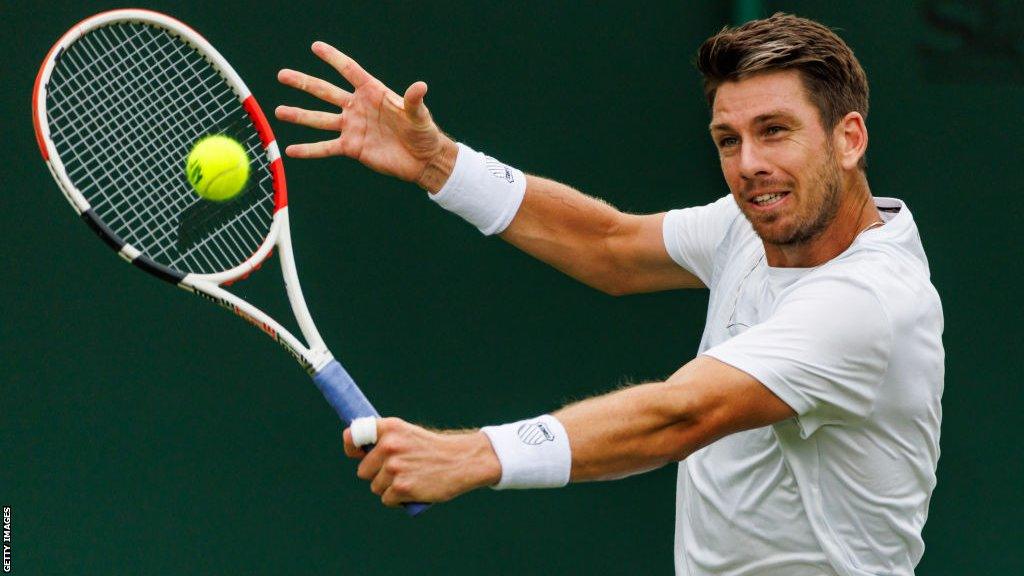Wimbledon 2023: What are tennis players doing to lower their carbon footprint?
- Published

British number one Cameron Norrie cycles to his matches in London
If you are a professional tennis player, you are likely to be clocking up at least 60,000 air miles a year.
With oceans to cross and one big tournament following on from another, air travel is usually the only option.
The men's ATP Tour has recently launched an app so players can track their carbon emissions, with the long-term ambition of inspiring greener travel.
One of those to sign up is world number 47 Emil Ruusuvuori, who wants to preserve his favourite haunt in his native Finland: a holiday home in the middle of nature.
"From Finland you pretty much have to fly everywhere. But last year I had a place in Milan for a couple of months and being able to either drive or use the train was a good change," he told BBC Sport.
"It's better to travel that way - you're able to walk around and even time-wise nothing really changes. For a couple of months, I didn't really take a flight at all. Geneva, Paris, Milan, Monte Carlo - quite a few tournaments I did by train or car."
"For me, one of the best places on Earth is back in Finland - a summer cottage. At any point of the year if I have a chance to go and relax, that's the best place, and that's in the middle of nature. You need a healthy environment and a healthy world to be able to have that."
Russian world number seven Andrey Rublev, British number one Cameron Norrie and 2020 US Open champion Dominic Thiem are the other players who have publicly pledged to monitor their emissions via the new Carbon Tracker app. They also say they will offset all of their tournament travel emissions in 2023 by purchasing carbon credits via the Gold Standard organisation.
Strawberries & plant-based cream? A sustainable day at Wimbledon
Will players really change their habits?
For tennis to make a real difference to its carbon footprint, however, players will need to make travel decisions which will inconvenience them both personally and professionally.
Will those very few who can afford private jets really reject them and wait for a scheduled flight to leave? Will players travel around Europe by train, when timetables allow, even though a journey will often take longer? And will players, having lost in the first round, resist the chance to cross the Atlantic for a rare few days at home - before flying back for the next tournament?
Norrie is honest about how difficult it will be to bring about a significant shift.
"I think the most important thing about the tracker is making other people and other players aware of how we are going about things and really trying to offset our carbon emissions," he said.
"It's not easy to try and change your travel plans a lot of the time and we are really trying to make sure that we are getting to places as quickly as possible - while being well rested. I think the main thing is making sure that we're doing the best we can for the situation we have in our sport - where we are travelling so much.
"It's not an easy one, but it's a good step forward. I'm really trying to use the trains a little bit more around Europe - I definitely prefer that.
"Here [in London] I'm riding my bike around and I've got an electric car as well, so I'm doing what I can."
There is geographical logic to the way the tours are designed. Both the ATP and the WTA Tours will spend several weeks in Europe in the spring, in North America in late summer and then in Asia in the autumn.
There are fewer home and away ties in the Davis Cup and Billie Jean King Cup these days, but there is still the potential for teams to have to fly thousands of miles for a two-day tie.
And then there are exhibitions which some choose to play in the very short off-season. Both Roger Federer in 2019, and Rafael Nadal and Casper Ruud in 2022, toured South America at the end of the regular season, delighting tens of thousands of fans in the process.
Players who engage with the app could be rewarded with a Green Badge, which will be displayed on their profile page on the ATP website.
"Bringing the awareness around the world to different people - for me that's the biggest thing," Ruusuvuori said.
"It's cool to have the opportunity to do it myself, but also to make people think maybe twice what they do."

A gripping twist on a classic cat-and-mouse story: Watch all episodes of We Hunt Together on BBC iPlayer
On-court legends and off-court revolutionaries: Meet the most iconic tennis players of the 1970s and 1980s

